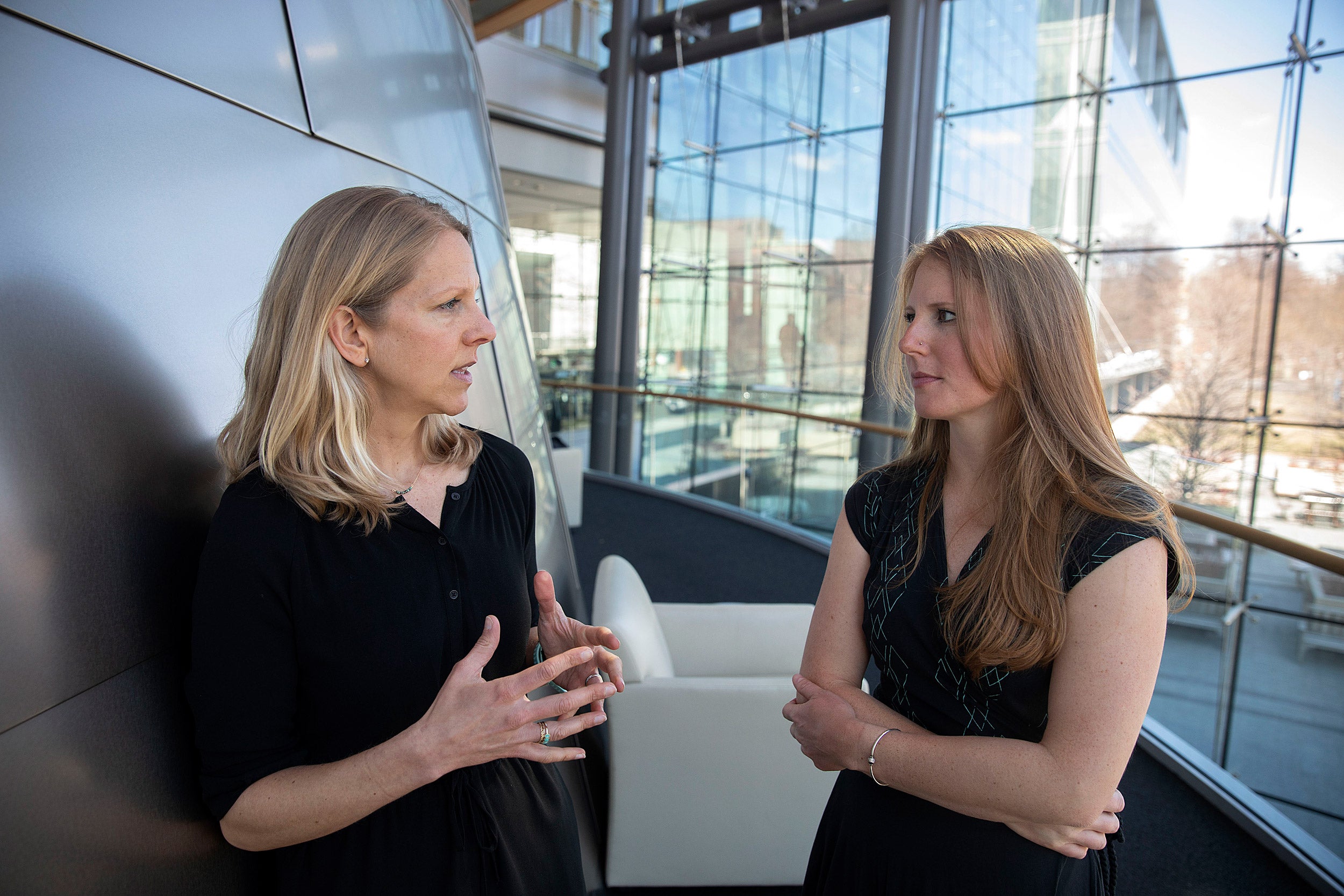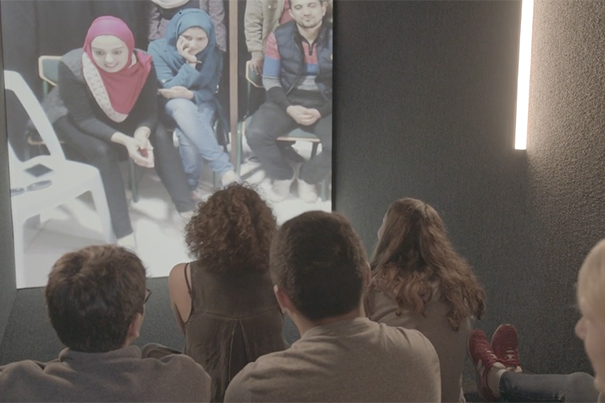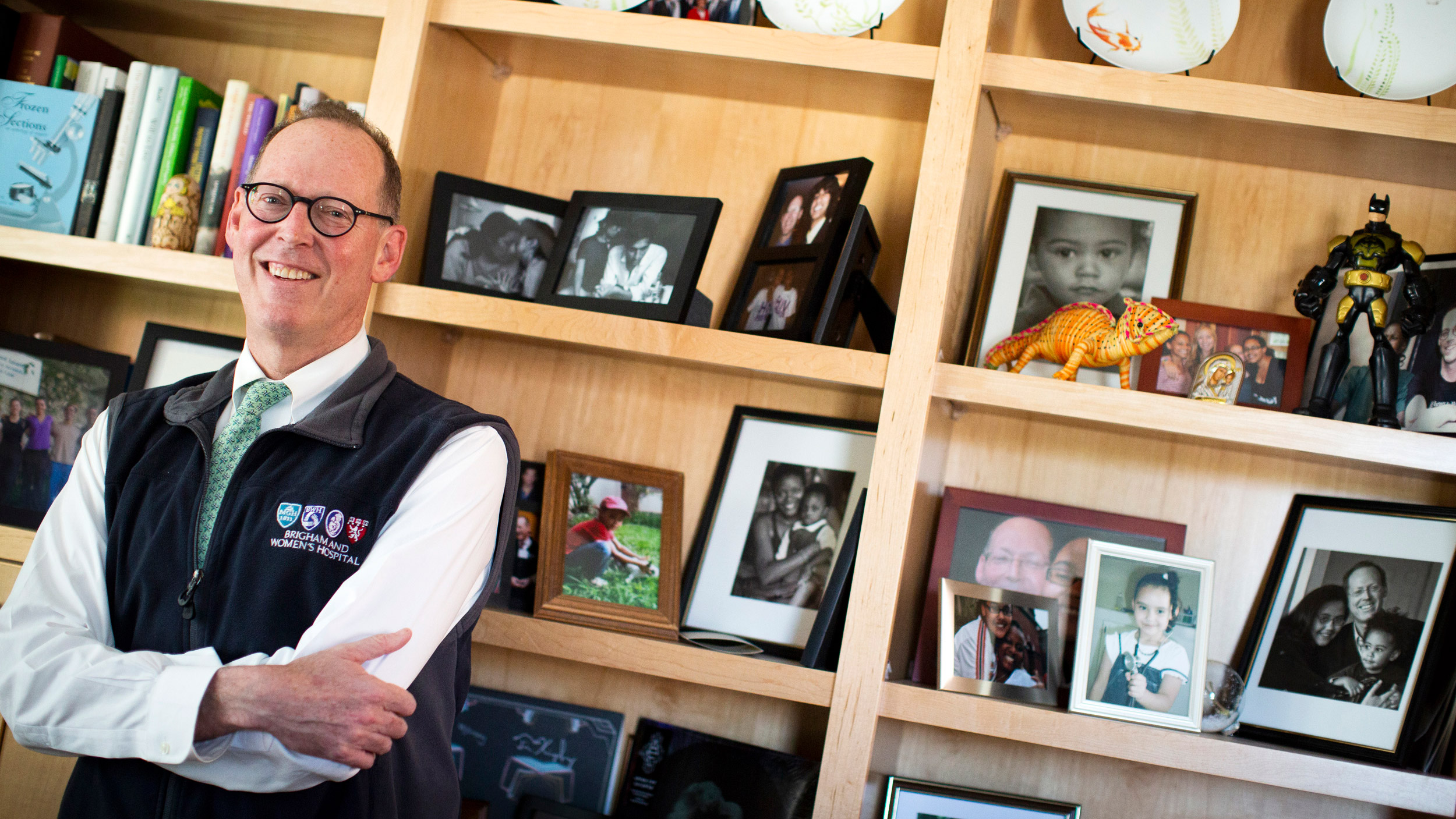
Sylvia Kehlenbrink (left) and Lindsay Jaacks have organized a Harvard Chan School symposium Thursday to tackle the increasing number of diabetics among refugee populations.
Kris Snibbe/Harvard Staff Photographer
Homeless, hopeless, and sick
Chan School symposium seeks care for increasing number of diabetics among refugees
With diabetes rapidly spreading around the globe, its prevalence among refugees and others fleeing war and natural disaster has also risen. But awareness of diabetes as a medical issue humanitarian workers should be ready to deal with has lagged.
That can lead to poor blood-sugar control among migrating diabetics and an unprepared medical system receiving them. That combination can be deadly for those with Type 1 diabetes — dependent on injections of insulin — and potentially debilitating for those with Type 2.
Lindsay Jaacks, assistant professor of global health at the Harvard T. H. Chan School of Public Health, and Sylvia Kehlenbrink, an instructor in medicine at Harvard Medical School and an endocrinologist at Brigham and Women’s Hospital, have convened a symposium to raise awareness, share experiences from the field, and begin to shape a broad strategy to address this issue.
Jaacks and Kehlenbrink discussed the April 4‒5 conference, at the Martin Conference Center in Longwood, with the Gazette, outlining the global diabetes landscape and noting the importance of players on the humanitarian scene — always struggling with scarce resources — coordinating efforts to address this challenge.
Q&A
Lindsay Jaacks and Sylvia Kehlenbrink
GAZETTE: How big a problem is diabetes globally?
JAACKS: It’s approaching half a billion people with diabetes globally right now. About 80 percent of those people are in low- and middle-income countries, in large part because China, India, Brazil — big countries — are low- and middle-income countries, but also because of a high prevalence in many of these countries. In India, where I do a lot of work, the prevalence of diabetes is actually quite similar to the prevalence in the U.S., which is quite shocking. In Mexico, the prevalence is more than double that in the U.S. None of these countries has a plateauing or declining rate of diabetes, so it’s only going to get worse as time goes on.
GAZETTE: Is this a relatively new phenomenon? Or is this something that has been going on for a long time and we’re just becoming aware of it?
JAACKS: It’s relatively new, but it depends on the country. Going back to Mexico and India, in cities — even 10 years ago — the prevalence was pretty high, especially among high-income individuals. The most recent phenomenon is this spread to rural areas. So it isn’t necessarily new for diabetes to be in these countries, but it’s new for it to be everywhere.
GAZETTE: Are we expecting it to become a bigger global problem, or has it plateaued?
KEHLENBRINK: Unfortunately, the projections are for a 48 percent increase in diabetes prevalence globally by year 2045, according to the International Diabetes Federation. The most dramatic increases are expected to occur in Africa and the Eastern Mediterranean regions. So, the prevalence is expected to go up everywhere in the world but by far most dramatically in low- and middle-income countries. At current estimates, it’s going to become an overwhelming issue, because even under stable conditions many of these countries are already struggling to fund and treat diabetes.
GAZETTE: In the context of the symposium and humanitarian crises, those areas that you mentioned — Africa, the Eastern Mediterranean — are where a lot of refugees and displaced people are from today.
KEHLENBRINK: That’s exactly right. We’re currently witnessing the highest numbers of global forced displacement on record due to conflicts, disaster, and disease outbreaks. Most recently, the crisis in Syria brought the noncommunicable disease (NCD) issue to light. In the Eastern Mediterranean region, diabetes prevalence is extremely high. So, many refugees leave their country with diabetes but humanitarian organizations are not equipped to treat it.
“The projections are for a 48 percent increase in diabetes prevalence globally by year 2045. … Even under stable conditions many of these countries are already struggling to fund and treat diabetes.”
Sylvia Kehlenbrink
GAZETTE: What happens to a diabetic who has been displaced and isn’t getting medicine or taking care of themselves?
KEHLENBRINK: Type 1 diabetes — that’s the autoimmune-mediated type of diabetes — is a lot less prevalent than Type 2 diabetes but a lot more deadly. High blood sugars due to lack of insulin can lead to diabetic ketoacidosis, which can be fatal within days or weeks if the person does not have access to insulin. So, if insulin is not available in the humanitarian responders’ medical kit, which it rarely is today, they will not survive. So this is an immediate need.
If someone has Type 2 diabetes and doesn’t get their medicine for a couple of weeks or even months, they will likely survive. However, if people are displaced for years, which is the new norm — on average 20 to 27 years — and their blood sugars are high and out of control for prolonged periods, they’re at higher risk of infection, not healing from wounds, developing blindness or kidney failure. If you have Type 2 diabetes with underlying cardiovascular disease, the stress of the situation can potentially lead to an acute heart attack or a stroke, which can lead to debilitating long-term complications.
Furthermore, Type 2 diabetes is occurring in younger people — 30s, 40s, 50s. Yesterday one of my colleagues at Doctors Without Borders was telling me that what has been so tragic to see in the field are young mothers with Type 2 diabetes. He’s seen quite a number who are blind from the disease and can no longer care for their children.
GAZETTE: Of the 68.5 million people displaced today, do we have any idea what proportion of them might be diabetic? Is there any reason to think it would be higher or lower than the general population?
KEHLENBRINK: There’s no clear data on that. That’s one of the reasons we’re convening the symposium, because the epidemiology and surveillance systems in the humanitarian arena do not routinely include noncommunicable diseases like diabetes.
They’re not consistently monitoring it and it’s hard to know what to make of the data that’s out there. We published a series last week in the Lancet Diabetes & Endocrinology journal on this very issue, looking at the literature on the burden of diabetes in a humanitarian context, and the data is really scarce.
GAZETTE: Why aren’t humanitarian workers thinking about noncommunicable diseases? Is it more of a long-term problem and they’re focused on the immediate? Or does a traditional bias make them overlook it because it hasn’t been a problem in decades past?
KEHLENBRINK: I would say all of the above. The topic has come up not infrequently over the past decade; however, organizations are confronted with competing priorities and the magnitude of the problem of diabetes and other NCDs has not been adequately recognized. I think organizations feel overwhelmed, because you have to treat NCDs regularly and you need trained staff and a system for continuity of care, which is difficult with groups of people on the move. How do you track their health needs over time? It’s not like a finite treatment course: a week with antibiotics for pneumonia.
And insulin is currently expensive and the cost of care overall quite high, although I think with thoughtful systems and programs the cost ultimately can be manageable.
GAZETTE: Let’s talk about the symposium itself. Where did this come from and who do you expect to attend?
KEHLENBRINK: I’ve been working on diabetes in crises over the past several years. During this time, I’ve observed a number of organizations working on similar projects on this topic, but not communicating or coordinating. I thought that this was really unfortunate because there’s limited funding and few people working directly on this problem. We should complement one another and leverage each other’s strengths to move this field forward. So that’s how the idea came about.
This is the first symposium on this topic. We now have about 100 people coming together, including representatives from the World Health Organization, the United Nations High Commissioner for Refugees, and Doctors Without Borders, among others.
I also want to point out that this issue is relevant to the U.S. as well. Natural disasters are increasing in frequency — I’m thinking about Puerto Rico and Hurricane Maria and Hurricane Harvey, which hit Houston — so this is not just an issue in lower- and middle-income countries. This is a high-income country issue too. It’s a U.S. issue.
GAZETTE: What do you hope participants leave with?
JAACKS: The ultimate goal is to bring everybody together to highlight the issues, to hear people in the field share experiences, to meet one another, and then to identify — because the needs are enormous — what are the most immediate needs, possible funding sources, and who can do what.
What we’re hoping to have come out of this is a “Boston Declaration” that identifies the most immediate needs and barriers to diabetes care, and ultimately to NCD care at large.
This interview has been lightly edited for length and clarity.








